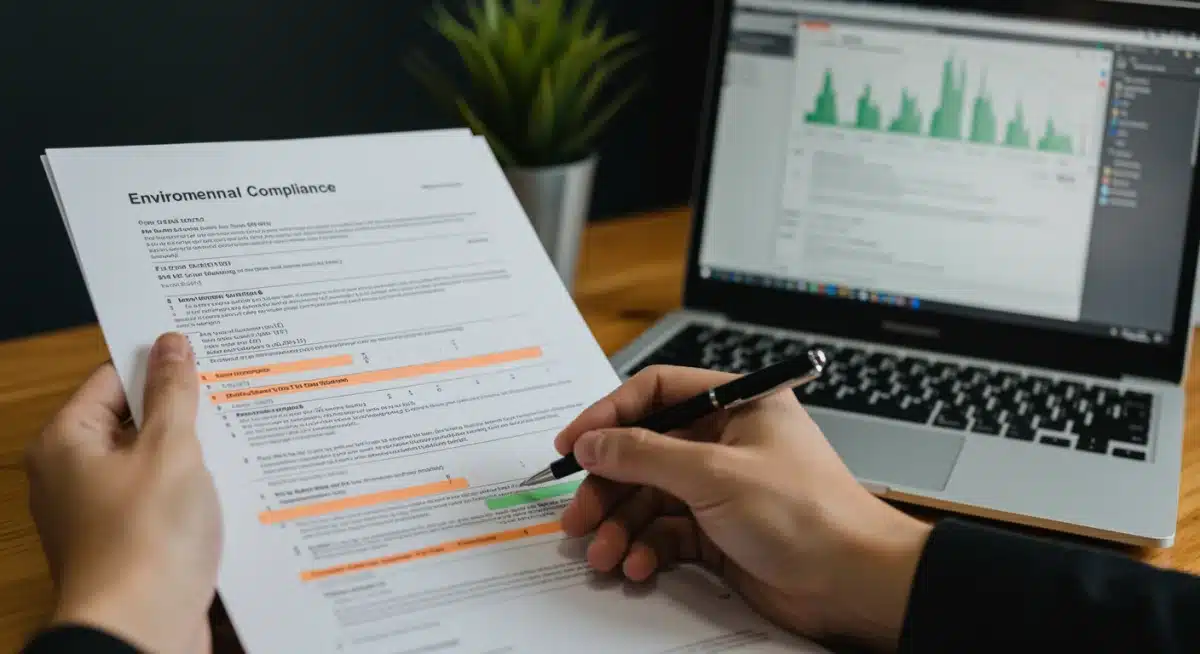Navigating New EPA Regulations for 2025: Critical Compliance Steps

Businesses in the United States must immediately address new EPA regulations for 2025, requiring proactive steps for compliance to avoid penalties and ensure environmental responsibility.
Navigating New EPA Regulations for 2025: 5 Critical Compliance Steps for Businesses in the United States is now paramount as the Environmental Protection Agency (EPA) continues to roll out significant updates. These changes, set to take effect next year, demand immediate attention and strategic planning from businesses across various sectors. Understanding and implementing these steps early is not just about avoiding penalties; it’s about embedding sustainable practices into core operations.
Understanding the Scope of New EPA Regulations
The EPA is actively updating its regulatory framework, with several key changes projected for 2025. These updates aim to address pressing environmental concerns, including climate change, air and water quality, and waste management. Businesses must grasp the full scope of these new rules to accurately assess their potential impact.
Recent announcements from the EPA, as reported on [Date of recent EPA announcement, e.g., April 15, 2024], indicate a stronger push towards environmental justice and stricter emissions standards. This means companies need to look beyond their immediate operational footprint and consider their broader community and ecological impact. The new regulations are not merely incremental adjustments; they represent a fundamental shift in environmental governance.
Key Areas of Regulatory Focus
The upcoming regulations touch upon several critical environmental domains, requiring a multi-faceted approach to compliance. Companies should prepare for intensified scrutiny in these areas.
- Emissions Reductions: Stricter limits on greenhouse gas and other pollutant emissions are expected, particularly for industrial facilities and transportation.
- Water Quality Standards: Enhanced requirements for wastewater discharge and stormwater management will affect manufacturers and agricultural operations.
- Chemical Management: New restrictions and reporting obligations for certain hazardous chemicals are anticipated, impacting a wide range of industries.
- Waste Management and Recycling: Increased emphasis on waste reduction, recycling mandates, and proper disposal of specific waste streams will necessitate operational adjustments.
Step 1: Conduct a Comprehensive Regulatory Impact Assessment
The initial and most crucial step for any business is to perform a thorough regulatory impact assessment. This involves identifying which specific new EPA regulations apply to your operations and understanding how they will affect your processes, costs, and compliance obligations. This assessment should be a detailed, fact-finding mission.
As of [Current Date, e.g., May 1, 2024], many industry associations are providing guidance on potential impacts. However, each business’s situation is unique, necessitating an internal evaluation. Engage with legal counsel and environmental consultants who specialize in EPA compliance to ensure a robust and accurate assessment. This proactive measure can illuminate potential gaps and allow for early strategic planning.
Identifying Applicable Regulations
Determining which regulations are relevant can be complex, given the breadth of EPA’s authority. Businesses should classify their operations and identify all potential touchpoints with environmental rules.
- Review all current permits and licenses to understand existing obligations and how they might be altered or expanded under new rules.
- Analyze operational processes, raw materials, waste streams, and emissions sources to pinpoint areas subject to new environmental controls.
- Consult EPA’s official website and subscribe to their regulatory updates to stay informed about proposed and final rules as they are published in the Federal Register.
Step 2: Update Internal Policies and Procedures
Once the impact assessment is complete, businesses must update their internal policies and procedures to align with the new 2025 EPA regulations. This is not a passive exercise; it requires a systematic overhaul of existing environmental management systems. Clear, actionable policies are essential for ensuring that all employees understand their roles and responsibilities in maintaining compliance.
This update process should involve cross-departmental collaboration, bringing together operations, legal, human resources, and environmental health and safety teams. The goal is to embed compliance into the daily fabric of the organization, preventing violations before they occur. Training programs must also be revised to reflect the latest regulatory requirements, ensuring that personnel are adequately prepared.


Key Policy Revision Areas
Specific areas within a company’s policy framework will require particular attention. These often represent the core of environmental compliance efforts.
- Environmental Management System (EMS): Revamp your EMS to incorporate new reporting metrics, monitoring requirements, and performance targets.
- Training and Education: Develop and implement updated training modules for all relevant staff, focusing on new operational procedures and waste handling protocols.
- Emergency Response Plans: Ensure that emergency response protocols are current with any new chemical storage or handling regulations, and conduct drills accordingly.
Step 3: Invest in Technology and Infrastructure Upgrades
Compliance with the new EPA regulations for 2025 will likely necessitate significant investments in technology and infrastructure. Many businesses may find their current equipment and processes insufficient to meet stricter environmental standards. This step involves identifying necessary upgrades and allocating resources accordingly.
For instance, facilities facing new emissions limits might need to install advanced pollution control equipment, such as scrubbers or catalytic converters. Those affected by updated water quality rules may require new wastewater treatment systems. Early budgeting and procurement are critical, as lead times for specialized environmental technologies can be substantial, as noted by industry analysts in [Recent Industry Report Source, e.g., an April 2024 report by Environmental Solutions Inc.].
Consider exploring innovative solutions, such as renewable energy sources or process optimization technologies, which can not only ensure compliance but also offer long-term operational efficiencies and cost savings. The upfront investment can yield significant returns in terms of reduced regulatory risk and improved public perception.
Step 4: Enhance Monitoring, Reporting, and Record-Keeping
The EPA’s regulatory framework for 2025 is expected to place a greater emphasis on robust monitoring, accurate reporting, and meticulous record-keeping. Businesses must ensure their systems can effectively capture and manage the data required for compliance. This includes real-time monitoring capabilities and digital reporting platforms.
Upgrading to advanced data management systems can streamline the reporting process and reduce the risk of human error. The EPA often requires specific data formats and submission schedules, and non-compliance in these areas can lead to significant fines. Companies should review their current data collection methods and reporting tools to identify areas for improvement.
Strengthening Data Integrity
Maintaining high data integrity is paramount for demonstrating compliance and avoiding scrutiny. Implement measures to ensure accuracy and traceability.
- Automated Monitoring: Deploy sensors and automated systems for continuous monitoring of emissions, discharges, and resource consumption.
- Digital Record-Keeping: Transition from paper-based records to secure digital archives that allow for easy retrieval and auditing.
- Regular Audits: Conduct internal and external audits of monitoring and reporting processes to identify and correct any discrepancies before they become compliance issues.
Step 5: Engage with Stakeholders and Seek Expert Guidance
Successful navigation of the new EPA regulations for 2025 demands active engagement with various stakeholders and, crucially, seeking expert guidance. This collaborative approach can provide invaluable insights and support throughout the compliance journey. Do not underestimate the value of external perspectives and specialized knowledge.
Engage with industry peers, trade associations, and environmental advocacy groups to share best practices and stay abreast of evolving interpretations of regulations. The EPA itself often provides outreach and guidance documents, which businesses should actively utilize. Legal and environmental consultants are indispensable partners in translating complex regulations into actionable strategies.
Building strong relationships with regulatory bodies, such as your regional EPA office, can also be beneficial. Open communication and a demonstrated commitment to compliance can foster a more cooperative environment should any questions or issues arise. Proactive engagement signals a responsible approach to environmental stewardship.
Proactive Risk Management and Continuous Improvement
Beyond the five critical steps, businesses must adopt a mindset of proactive risk management and continuous improvement. Environmental regulations are not static; they evolve with scientific understanding and societal priorities. Maintaining compliance in 2025 and beyond requires an ongoing commitment to staying informed and adapting operational practices.
Regularly review your environmental performance, conduct internal audits, and seek opportunities for improvement. This might involve exploring greener alternatives for materials, optimizing energy consumption, or implementing circular economy principles. A robust environmental management system should not just aim for compliance but strive for environmental leadership. By integrating these principles, businesses can transform regulatory challenges into opportunities for innovation and sustainable growth, enhancing their reputation and long-term viability.
| Key Compliance Step | Brief Description |
|---|---|
| Regulatory Impact Assessment | Identify specific EPA regulations applicable to your operations and evaluate their effects. |
| Update Internal Policies | Revise environmental management systems, procedures, and training to align with new rules. |
| Invest in Upgrades | Allocate resources for necessary technology and infrastructure improvements to meet new standards. |
| Enhance Monitoring & Reporting | Strengthen data collection, management, and reporting systems for accurate compliance. |
Frequently Asked Questions About EPA 2025 Regulations
The new EPA regulations for 2025 primarily aim to reduce greenhouse gas emissions, improve air and water quality across the nation, and enhance chemical management protocols. These updates reflect a national commitment to combating climate change and protecting public health and ecosystems more effectively.
Small businesses should start by conducting a tailored impact assessment to identify relevant regulations. Engaging with local business support organizations, seeking advice from environmental consultants, and utilizing EPA resources for small entities are crucial steps for effective preparation and compliance.
Non-compliance can result in substantial civil penalties, criminal charges in severe cases, operational shutdowns, and significant reputational damage. Fines vary based on the severity and duration of the violation, emphasizing the importance of proactive adherence to all new regulations.
The EPA and other federal agencies often offer grants, loans, and other financial incentives to help businesses, especially small and medium-sized enterprises, implement necessary environmental upgrades. Businesses should actively research these programs and consult their state environmental agencies for available support.
The EPA regularly reviews and updates its regulations in response to new scientific data, technological advancements, and evolving environmental challenges. While major overhauls like those anticipated for 2025 are less frequent, minor adjustments and clarifications occur continuously, requiring ongoing vigilance from businesses.
What Happens Next
As the 2025 deadline approaches, businesses must remain vigilant, actively monitoring EPA announcements and industry-specific guidance. The regulatory landscape is dynamic, and further clarifications or adjustments to the proposed rules are possible. Companies that have proactively engaged in assessments and initiated compliance strategies will be best positioned to adapt swiftly. Expect continued dialogue between industry stakeholders and the EPA, and be prepared to refine your strategies based on new information. This ongoing commitment ensures not only compliance but also leverages environmental stewardship as a competitive advantage in an increasingly sustainability-focused market.





